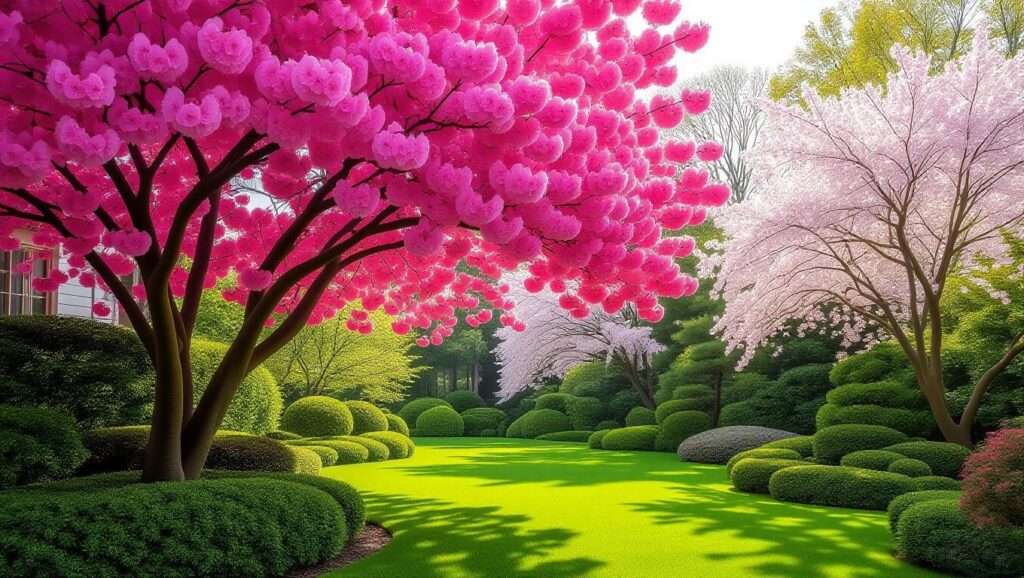Picture this: you step into your garden, and a cascade of vibrant pink blooms greets you, swaying gently in the breeze. Neighbors pause to admire, pollinators buzz with delight, and your outdoor space feels like a serene retreat. Trees with pink flowers can turn this vision into reality, transforming any yard into a breathtaking haven. Whether you’re a seasoned gardener or a beginner looking to elevate your landscape, these trees offer unmatched beauty and ecological benefits. In this comprehensive guide, we’ll explore the best trees with pink flowers, share expert care tips, and provide design inspiration to help you create a stunning garden. Written by a horticulture expert with over a decade of experience in tree care and landscape design, this article is your go-to resource for choosing and nurturing these vibrant beauties. 🌺
Why Choose Trees with Pink Flowers? 🌸
Aesthetic and Emotional Impact
Pink-flowering trees are more than just plants—they’re statements of elegance and warmth. Their soft, rosy hues create a welcoming atmosphere, making your garden feel like a sanctuary. Psychologically, pink evokes calmness, joy, and creativity, which can uplift your mood every time you step outside. For example, a single Japanese flowering cherry tree in full bloom can become the heart of your garden, drawing eyes and sparking conversations. These trees add a pop of color that complements green lawns or neutral hardscapes, creating a balanced and inviting aesthetic. 🌷
Ecological Benefits
Beyond their beauty, pink-flowering trees are ecological powerhouses. Their nectar-rich blooms attract pollinators like bees, butterflies, and hummingbirds, supporting local biodiversity. A healthy population of pollinators boosts fruit and vegetable yields in your garden, making these trees a win-win for aesthetics and functionality. Additionally, their canopies provide shade, reduce urban heat, and improve air quality by filtering pollutants. For instance, a flowering crabapple tree not only dazzles with pink blossoms but also supports wildlife with its fall fruit. 🐝
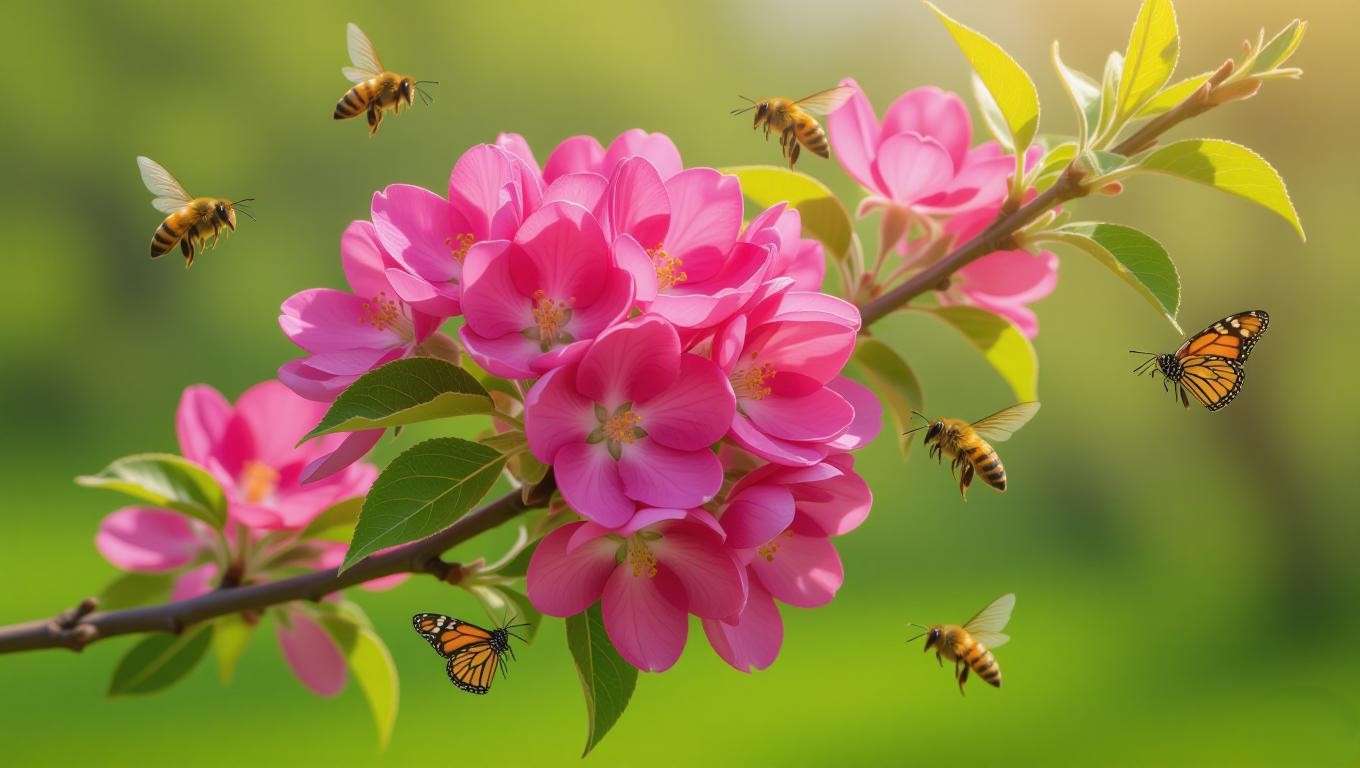
Versatility in Garden Design
Pink-flowering trees are incredibly versatile, fitting into gardens of all sizes and styles. From compact redbuds for small urban yards to sprawling magnolias for large estates, there’s a variety for every space. They pair beautifully with other plants, like evergreen shrubs or colorful perennials, creating a cohesive look. Expert Tip: Plant a pink dogwood near a low-growing lavender bed for a stunning contrast that blooms from spring to summer. Their adaptability across climates and design preferences makes them a must-have for any garden enthusiast. 🌿
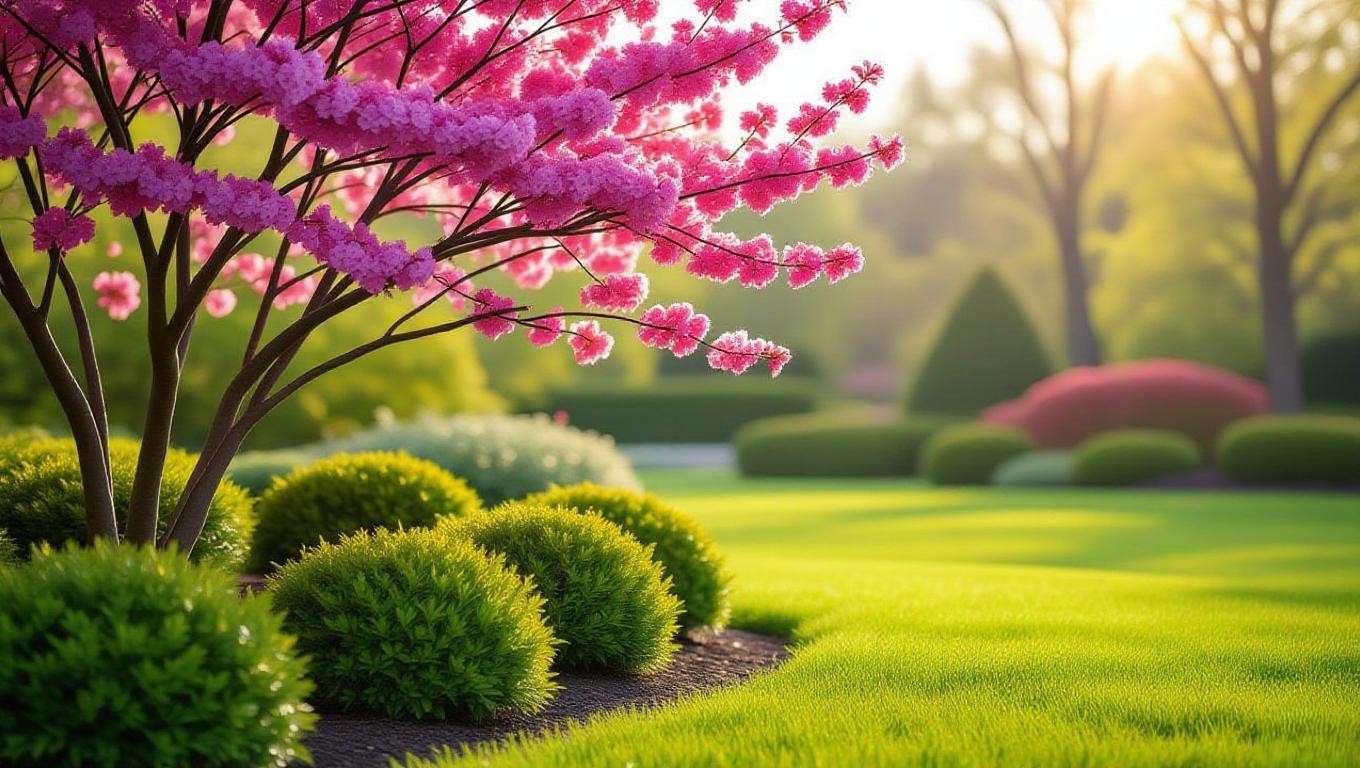
Top 5 Trees with Pink Flowers for Your Garden 🌺
1. Flowering Crabapple (Malus spp.) 🍎
Description: Flowering crabapples are small to medium-sized trees (15–25 feet tall) that burst into a sea of pink blossoms in spring. Their vibrant flowers give way to colorful fruit in fall, adding multi-seasonal interest.
Key Varieties:
- Malus ‘Prairifire’: Deep pink-red flowers and dark red fruit.
- Malus ‘Royal Raindrops’: Bright pink blooms and burgundy foliage.
Growing Conditions: Thrives in USDA Zones 4–8, preferring full sun and well-drained soil.
Care Tips: Prune in late winter to maintain shape and remove dead branches. Fertilize annually with a balanced, slow-release fertilizer. Watch for pests like aphids and treat with neem oil if needed.
Why It’s Great: Crabapples offer dual appeal with pink flowers and edible or ornamental fruit, making them ideal for gardeners seeking beauty and utility.
2. Eastern Redbud (Cercis canadensis) 💗
Description: Known for its heart-shaped leaves and delicate pink-lavender flowers, the Eastern redbud is a compact tree (20–30 feet tall) that blooms profusely in early spring.
Key Variety: Cercis canadensis ‘Forest Pansy’ features deeper pink flowers and purple foliage.
Growing Conditions: Grows in USDA Zones 4–9, tolerating partial shade to full sun and preferring moist, well-drained soil.
Care Tips: Water regularly during the first year to establish roots. Avoid over-pruning, as redbuds bloom on old wood. Protect from root damage during lawn maintenance.
Why It’s Great: Its early blooms and small size make it perfect for urban gardens or as an understory tree in larger landscapes.
3. Pink Dogwood (Cornus florida ‘Rubra’) 🌸
Description: Pink dogwoods are elegant trees (20–40 feet tall) with soft pink bracts that resemble flowers, blooming for weeks in spring. Their red fall foliage adds extra charm.
Growing Conditions: Best in USDA Zones 5–9, preferring partial shade and acidic, well-drained soil.
Care Tips: Mulch around the base to retain moisture and protect roots. Water deeply during dry spells to prevent stress. Monitor for anthracnose, a fungal disease, and treat early with fungicides.
Why It’s Great: Long blooming periods and vibrant fall colors make pink dogwoods a standout choice for year-round interest.
4. Japanese Flowering Cherry (Prunus serrulata) 🌸
Description: Famous for their iconic cherry blossoms, these trees (15–25 feet tall) produce clouds of pink flowers in spring, creating a breathtaking display.
Key Varieties:
- Prunus ‘Kanzan’: Double pink flowers with a bold presence.
- Prunus ‘Shogetsu’: Soft pink, semi-double blooms.
Growing Conditions: USDA Zones 5–8, requiring full sun and well-drained soil.
Care Tips: Prune lightly after flowering to maintain shape. Prevent fungal diseases by ensuring good air circulation. Water consistently during establishment.
Why It’s Great: Their cultural significance and show-stopping blooms make them a favorite for spring festivals and home gardens alike.
5. Saucer Magnolia (Magnolia × soulangeana) 🌷
Description: Saucer magnolias (20–30 feet tall) boast large, cup-shaped flowers in pinkish-purple hues, blooming early in spring before leaves emerge.
Growing Conditions: USDA Zones 4–9, thriving in full sun to partial shade with rich, well-drained soil.
Care Tips: Maintain soil pH between 5.0 and 6.5 for optimal growth. Protect from late frosts, which can damage early blooms. Mulch to conserve moisture.
Why It’s Great: Their dramatic floral display makes them a bold choice for gardeners seeking a wow factor.
How to Choose the Right Pink-Flowering Tree for Your Garden 🌳
Assessing Your Garden’s Conditions
Selecting the perfect tree starts with understanding your garden’s environment. Check your USDA Hardiness Zone to ensure the tree can withstand your local climate. For example, pink dogwoods thrive in Zones 5–9, while crabapples tolerate colder Zones 4–8. Test your soil for pH and drainage—most pink-flowering trees prefer slightly acidic, well-drained soil. Evaluate sunlight: Japanese cherries need full sun, while redbuds tolerate partial shade. Measure your available space to avoid overcrowding; a saucer magnolia needs room to spread, while a redbud suits smaller yards. 🌱
Matching Trees to Your Aesthetic Goals
Consider how the tree fits your garden’s design. Want a focal point? A pink dogwood’s broad canopy draws attention. Prefer a subtle accent? A redbud’s delicate blooms blend beautifully with other plants. Think about seasonal interest: Crabapples offer fall fruit, while dogwoods provide stunning autumn foliage. Expert Insight: Visit a local botanical garden to see these trees in action and visualize their impact in your space. Align your choice with your garden’s color scheme—pink blooms pair well with purples, whites, and greens. 🌼
Budget and Maintenance Considerations
Young trees are more affordable but require more care during establishment. Expect to spend $50–$200 depending on size and variety. For low-maintenance options, redbuds and crabapples require less fuss than magnolias, which are sensitive to frost. Factor in long-term costs like fertilizers, mulch, and occasional pest control. Tip: Shop at local nurseries for healthy, region-specific trees and ask about warranties. Investing time in proper planting and care saves money on replacements later. 🌿
Planting and Caring for Pink-Flowering Trees 🌿
Planting Tips for Success
Plant in early spring or fall for the best root establishment. Dig a hole twice as wide and as deep as the root ball, mixing in compost for nutrient-rich soil. Place the tree so the root flare sits slightly above ground level, and backfill gently to avoid air pockets. Stake young trees to protect against wind. Common mistakes include planting too deep, which suffocates roots, or overwatering, which causes rot. Tip: Water thoroughly after planting and mulch with 2–3 inches of organic material to retain moisture. 🌳
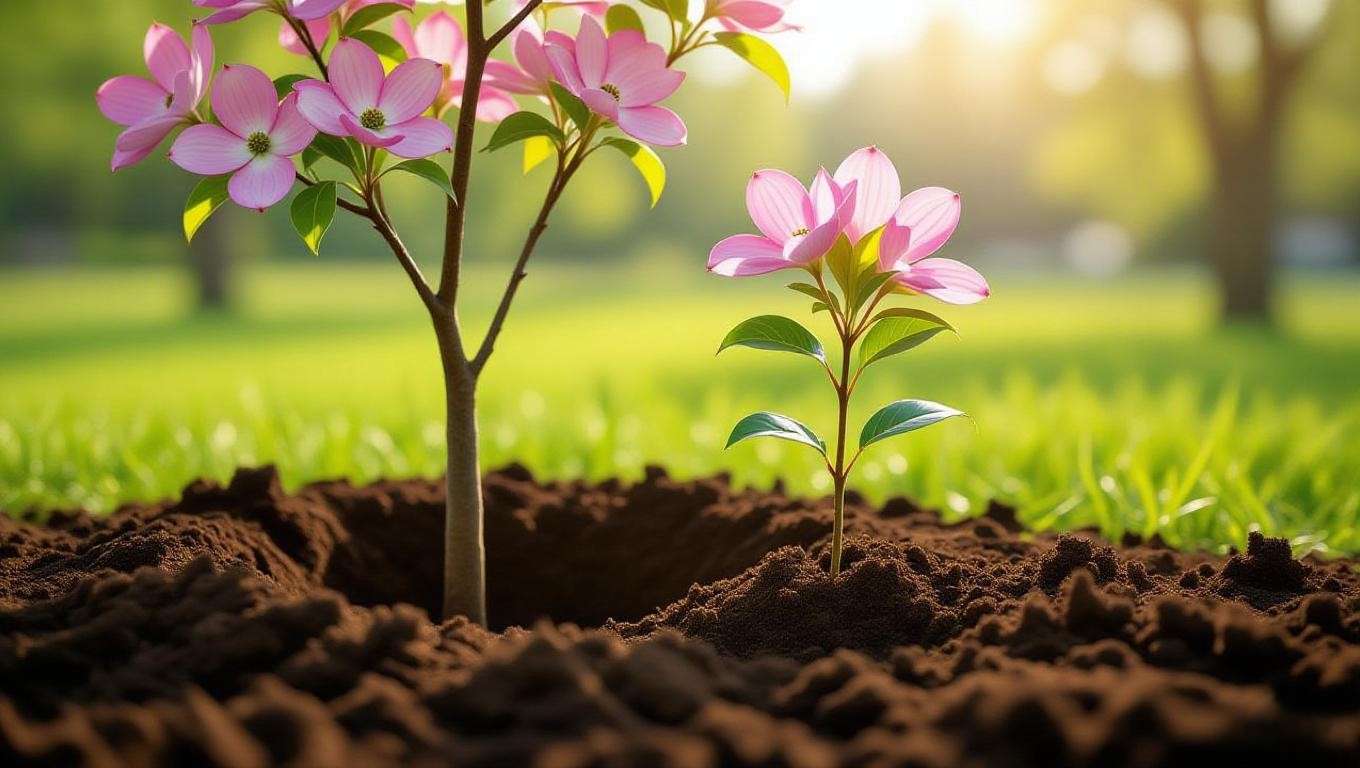
Watering and Fertilizing
Young trees need consistent watering—about 1 inch per week for the first year. Established trees are more drought-tolerant but benefit from deep watering during dry spells. Use a balanced, slow-release fertilizer (10-10-10) in early spring to boost growth and flowering. Avoid over-fertilizing, which can lead to excessive foliage at the expense of blooms. Expert Tip: Apply fertilizer around the drip line, not near the trunk, for optimal nutrient absorption. 🌻
Pruning and Maintenance
Prune in late winter or early spring before buds swell, focusing on dead, damaged, or crossing branches. For trees like redbuds and cherries, avoid heavy pruning, as they bloom on old wood. Clean tools with alcohol to prevent disease spread. Monitor for pests like aphids or scale and use organic treatments like neem oil. A seasonal maintenance checklist includes spring fertilization, summer watering, fall mulching, and winter inspections for damage. 🌸
Winter Care and Protection
In colder climates, protect roots with a 3–4-inch layer of mulch, keeping it away from the trunk to prevent rot. Wrap young trunks with burlap to shield against frost cracks. For frost-sensitive trees like saucer magnolias, cover buds during late frosts with breathable fabric. Tip: Choose winter-hardy varieties like ‘Prairifire’ crabapple for Zones 4–5 to minimize winter damage. ❄️
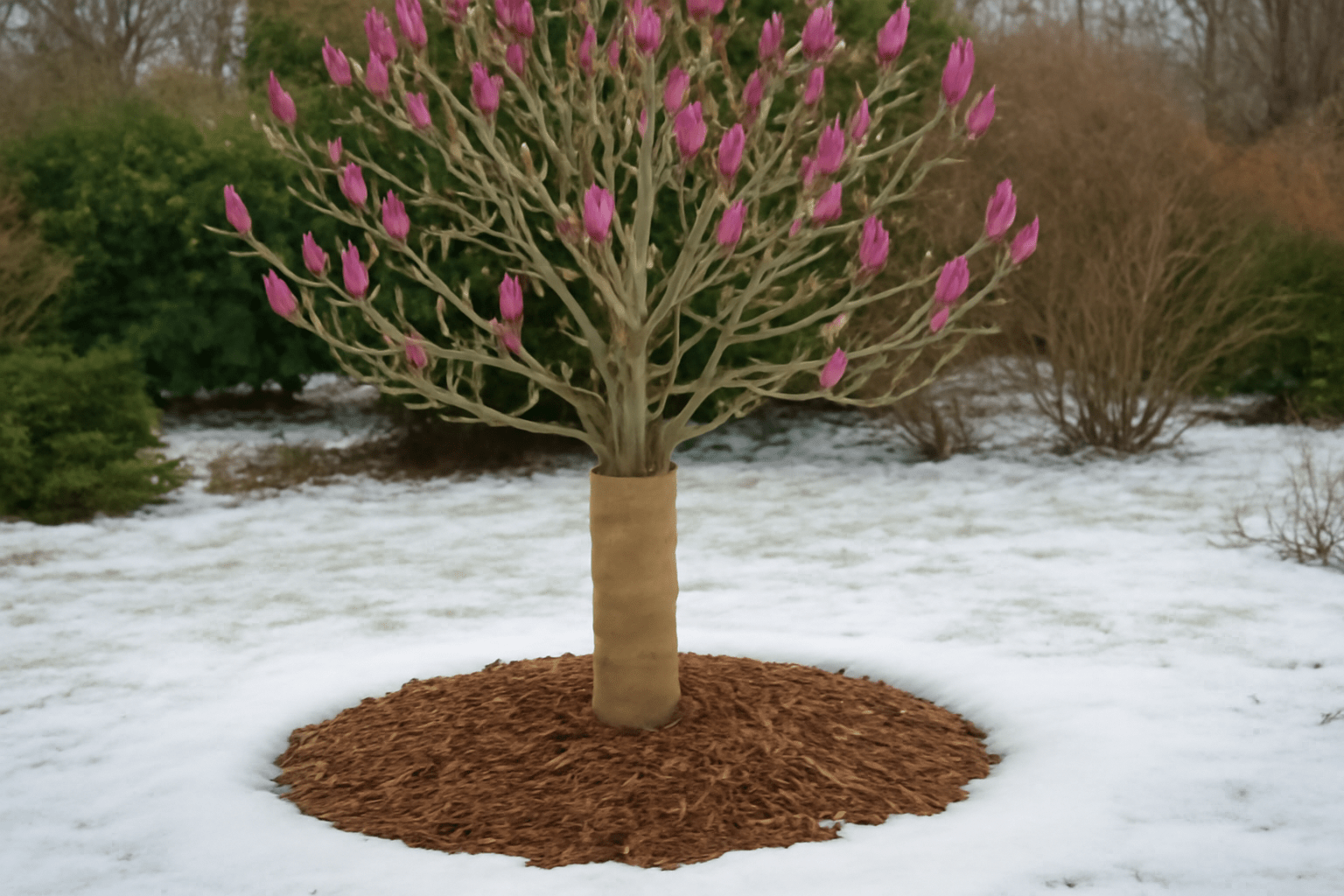
Designing Your Garden with Pink-Flowering Trees 🌺
Creating Focal Points
Pink-flowering trees are natural showstoppers, perfect for creating focal points in your garden. A single Japanese flowering cherry or saucer magnolia can anchor a small yard, drawing the eye with its vibrant blooms. Place the tree in a prominent spot, such as the center of a lawn or near a patio, to maximize its impact. For larger gardens, consider planting a pink dogwood at the end of a pathway to create a dramatic vista. Surround the tree with low-growing plants like hostas or ferns to highlight its structure without competing for attention. Tip: Add a simple bench nearby to invite visitors to linger and enjoy the view. 🌸
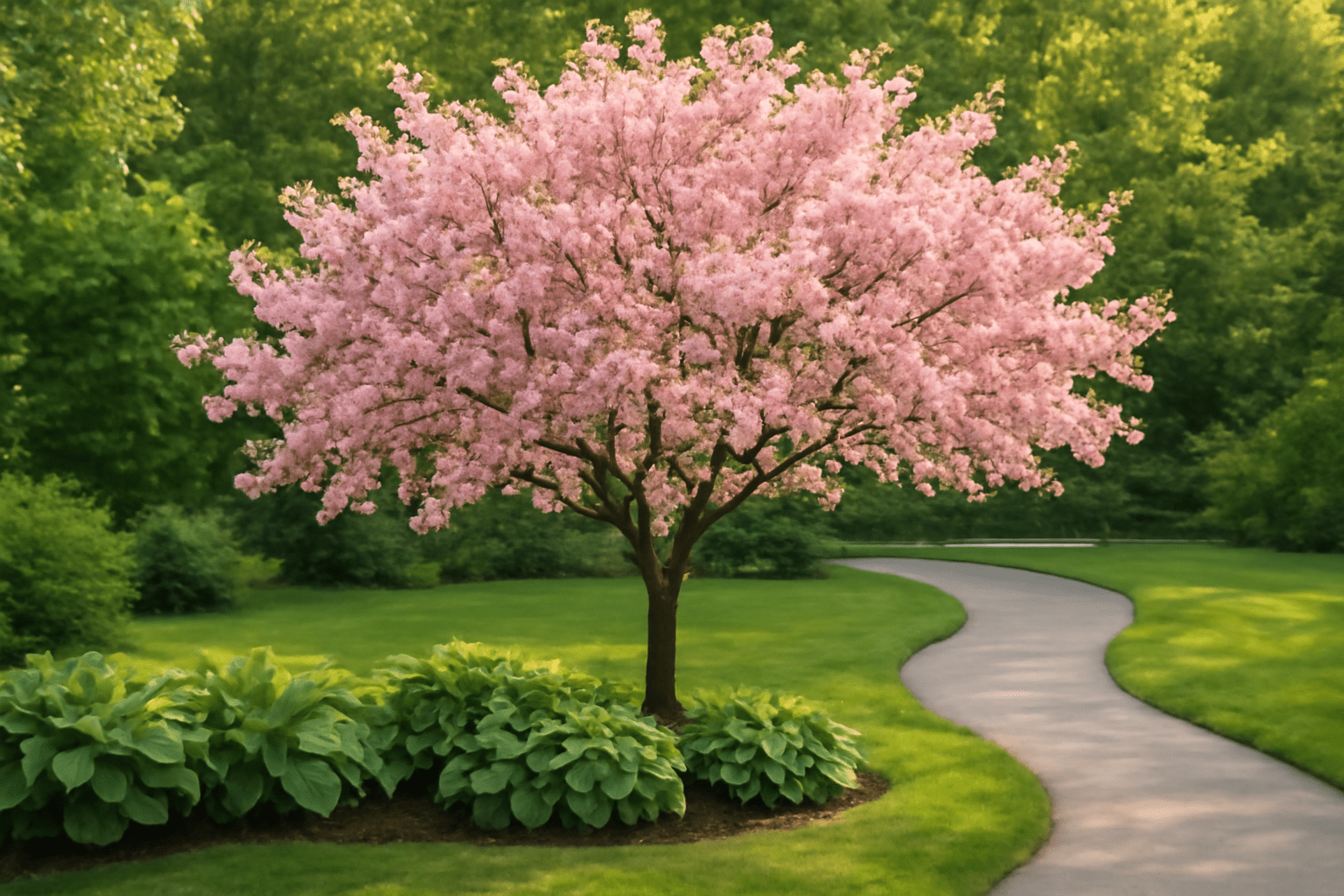
Combining with Other Colors and Textures
Pink blooms pair beautifully with a range of colors and textures to create a harmonious garden. For a classic look, combine pink-flowering trees with green foliage plants like boxwoods or evergreen shrubs, which provide a neutral backdrop. For a bolder design, pair with purple-leafed plants like Physocarpus ‘Diabolo’ or lavender perennials for a vibrant contrast. Ornamental grasses, such as Miscanthus sinensis, add texture and movement, complementing the soft petals of a redbud or crabapple. Example: A pink dogwood underplanted with white azaleas and purple salvia creates a stunning spring display that transitions seamlessly into summer. 🌼
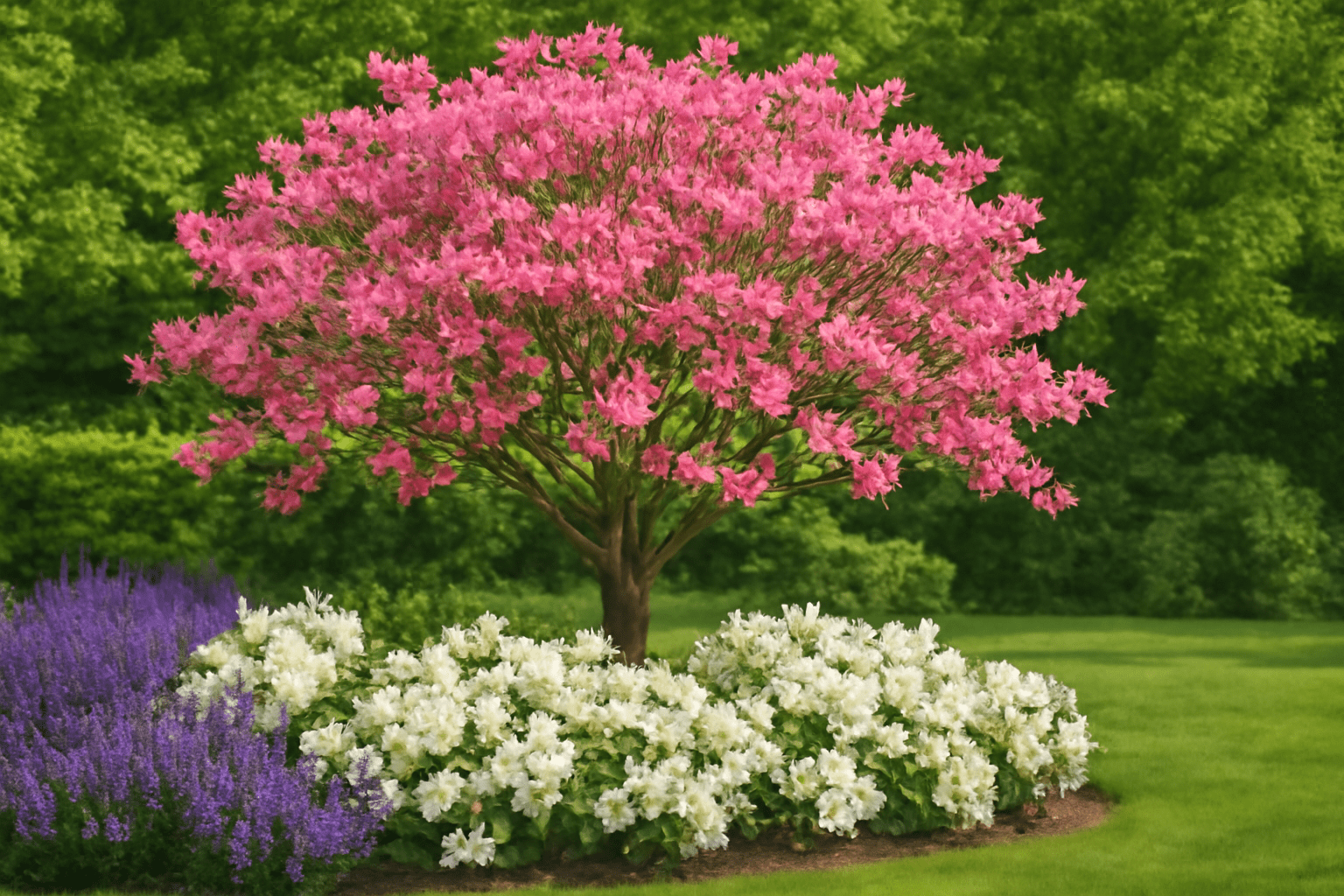
Seasonal Garden Planning
To ensure year-round beauty, integrate pink-flowering trees with plants that offer complementary seasonal interest. For spring, pair with early bloomers like tulips or daffodils. In summer, add perennials like coneflowers or daylilies to maintain color after the tree’s blooms fade. For fall, choose companions with striking foliage, such as burning bush or Japanese maples. Evergreens like junipers or hollies provide winter structure, ensuring your garden remains attractive even when the tree is bare. Expert Insight: Plan for layered planting—tall trees, mid-level shrubs, and groundcovers—to create depth and visual harmony. 🌿
Common Challenges and Solutions for Pink-Flowering Trees 🌳
Pest and Disease Management
Pink-flowering trees can face pests like aphids, scale, or Japanese beetles, which feed on leaves and sap. Regular inspections help catch infestations early. For organic control, spray neem oil or insecticidal soap, focusing on the undersides of leaves. Fungal diseases, such as powdery mildew or anthracnose, are common in humid climates. Ensure good air circulation by pruning dense canopies and avoid overhead watering. For severe cases, apply a fungicide labeled for your tree species. Tip: Introduce beneficial insects like ladybugs to naturally control aphid populations. 🐞
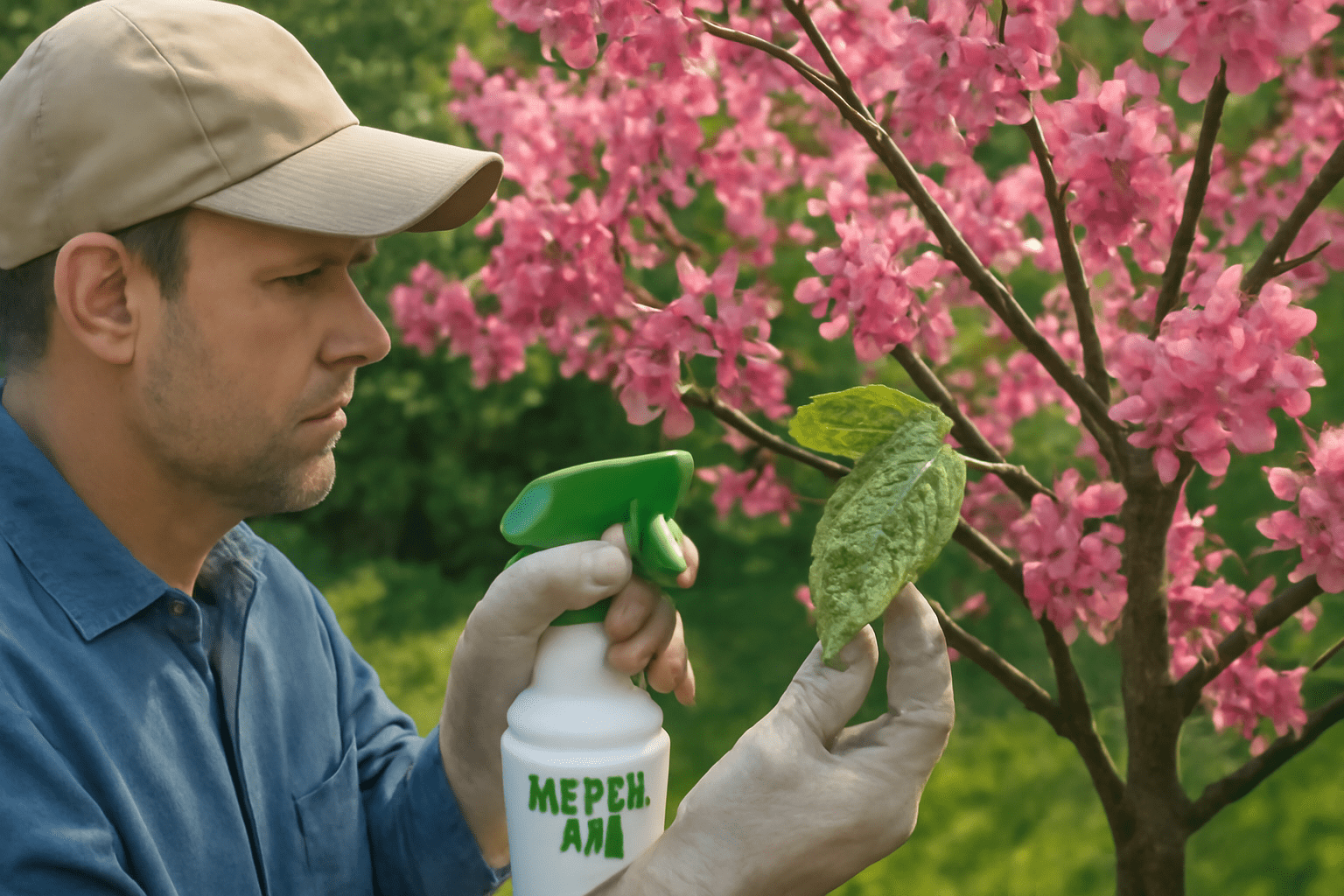
Environmental Stressors
Drought, heat, or poor soil can stress pink-flowering trees, reducing blooms or causing leaf drop. To combat drought, install a drip irrigation system or water deeply during dry spells. Improve poor soil with organic amendments like compost or aged manure before planting. In hot climates, provide afternoon shade for sensitive trees like dogwoods. Expert Insight: Test your soil annually for nutrient deficiencies using a home kit or local extension service, and adjust with targeted fertilizers to keep your tree thriving. 🌱
Bloom Failure and How to Fix It
If your tree isn’t blooming, the issue could be improper pruning, nutrient imbalance, or too much shade. Pruning at the wrong time—such as late spring for redbuds—removes flower buds. Stick to late winter pruning for most species. Nutrient imbalances, like excess nitrogen, promote leafy growth over flowers. Use a phosphorus-rich fertilizer (e.g., 5-10-5) to encourage blooms. If the tree is in heavy shade, consider relocating it or trimming nearby plants to increase sunlight. Tip: Patience is key—young trees may take 2–3 years to establish before producing abundant blooms. 🌸
FAQs About Trees with Pink Flowers ❓
What are the best pink-flowering trees for small gardens? 🌸
Compact trees like Eastern redbuds or dwarf crabapples (Malus ‘Coralburst’) are ideal for small spaces, growing to 15–20 feet and fitting well in urban yards or courtyards.
How long do pink-flowering trees bloom? ⏰
Bloom times vary: Japanese cherries and magnolias bloom for 1–2 weeks in spring, while dogwoods and crabapples can last 2–4 weeks, depending on weather conditions.
Can pink-flowering trees grow in hot climates? ☀️
Yes, redbuds and certain crabapple varieties thrive in warmer Zones 7–9. Ensure proper irrigation and afternoon shade for heat-sensitive trees like dogwoods.
How do I prevent pests on my flowering trees? 🐞
Regularly inspect for pests, use organic sprays like neem oil, and encourage natural predators like birds by installing feeders or nesting boxes.
Which pink-flowering trees are low-maintenance? 🌿
Eastern redbuds and crabapples require minimal care once established, needing only occasional pruning and fertilization compared to magnolias or cherries.
Conclusion: Transform Your Garden with Pink-Flowering Trees 🌺
Trees with pink flowers are more than just ornamental—they’re a gateway to a vibrant, ecologically rich garden that captivates year after year. From the delicate blossoms of a Japanese cherry to the bold cups of a saucer magnolia, these trees offer beauty, versatility, and environmental benefits. By choosing the right tree for your climate, soil, and aesthetic goals, and following expert care tips, you can create a stunning outdoor space that inspires awe. Start planning today: visit a local nursery, explore your options, and share your favorite pink-flowering tree in the comments below. Final Expert Tip: Tour a nearby botanical garden for real-world inspiration before making your choice. Your dream garden is just a tree away! 🌳

